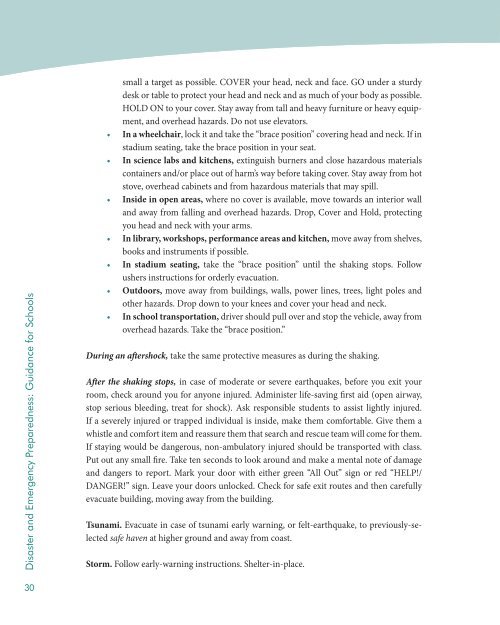Disaster and Emergency Preparedness: Guidance for ... - INEE Toolkit
Disaster and Emergency Preparedness: Guidance for ... - INEE Toolkit
Disaster and Emergency Preparedness: Guidance for ... - INEE Toolkit
You also want an ePaper? Increase the reach of your titles
YUMPU automatically turns print PDFs into web optimized ePapers that Google loves.
<strong>Disaster</strong> <strong>and</strong> <strong>Emergency</strong> <strong>Preparedness</strong>: <strong>Guidance</strong> <strong>for</strong> Schoolssmall a target as possible. COVER your head, neck <strong>and</strong> face. GO under a sturdydesk or table to protect your head <strong>and</strong> neck <strong>and</strong> as much of your body as possible.HOLD ON to your cover. Stay away from tall <strong>and</strong> heavy furniture or heavy equipment,<strong>and</strong> overhead hazards. Do not use elevators.In a wheelchair, lock it <strong>and</strong> take the “brace position” covering head <strong>and</strong> neck. If instadium seating, take the brace position in your seat.In science labs <strong>and</strong> kitchens, extinguish burners <strong>and</strong> close hazardous materialscontainers <strong>and</strong>/or place out of harm’s way be<strong>for</strong>e taking cover. Stay away from hotstove, overhead cabinets <strong>and</strong> from hazardous materials that may spill.Inside in open areas, where no cover is available, move towards an interior wall<strong>and</strong> away from falling <strong>and</strong> overhead hazards. Drop, Cover <strong>and</strong> Hold, protectingyou head <strong>and</strong> neck with your arms.In library, workshops, per<strong>for</strong>mance areas <strong>and</strong> kitchen, move away from shelves,books <strong>and</strong> instruments if possible.In stadium seating, take the “brace position” until the shaking stops. Followushers instructions <strong>for</strong> orderly evacuation.Outdoors, move away from buildings, walls, power lines, trees, light poles <strong>and</strong>other hazards. Drop down to your knees <strong>and</strong> cover your head <strong>and</strong> neck.In school transportation, driver should pull over <strong>and</strong> stop the vehicle, away fromoverhead hazards. Take the “brace position.”During an aftershock, take the same protective measures as during the shaking.After the shaking stops, in case of moderate or severe earthquakes, be<strong>for</strong>e you exit yourroom, check around you <strong>for</strong> anyone injured. Administer life-saving first aid (open airway,stop serious bleeding, treat <strong>for</strong> shock). Ask responsible students to assist lightly injured.If a severely injured or trapped individual is inside, make them com<strong>for</strong>table. Give them awhistle <strong>and</strong> com<strong>for</strong>t item <strong>and</strong> reassure them that search <strong>and</strong> rescue team will come <strong>for</strong> them.If staying would be dangerous, non-ambulatory injured should be transported with class.Put out any small fire. Take ten seconds to look around <strong>and</strong> make a mental note of damage<strong>and</strong> dangers to report. Mark your door with either green “All Out” sign or red “HELP!/DANGER!” sign. Leave your doors unlocked. Check <strong>for</strong> safe exit routes <strong>and</strong> then carefullyevacuate building, moving away from the building.Tsunami. Evacuate in case of tsunami early warning, or felt-earthquake, to previously-selectedsafe haven at higher ground <strong>and</strong> away from coast.Storm. Follow early-warning instructions. Shelter-in-place.30
















